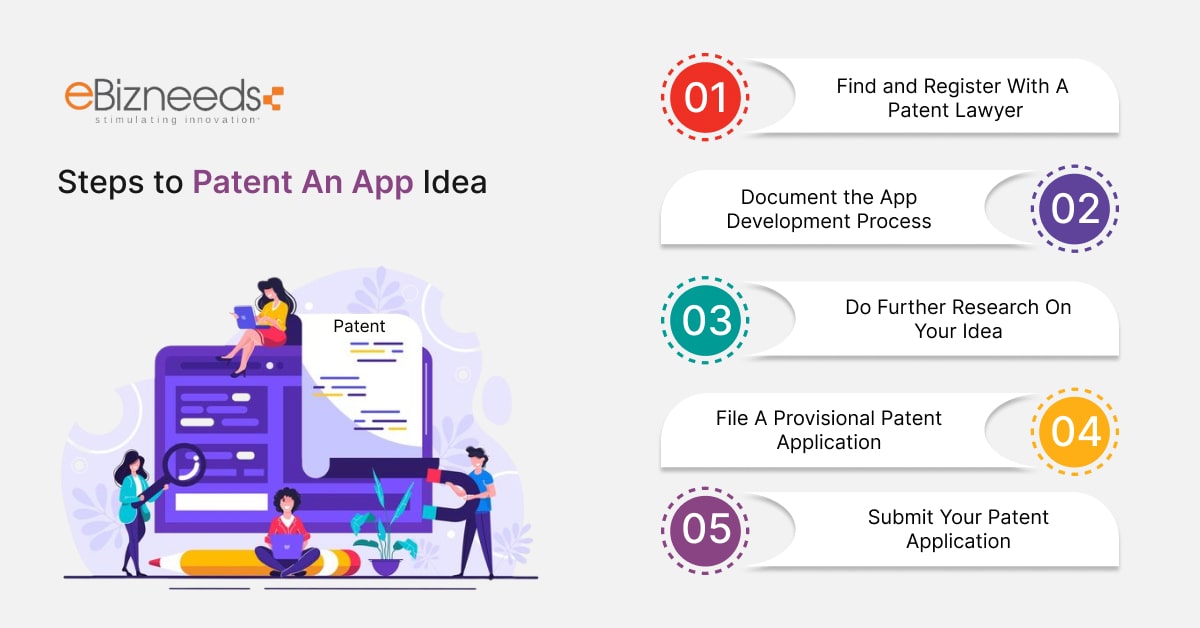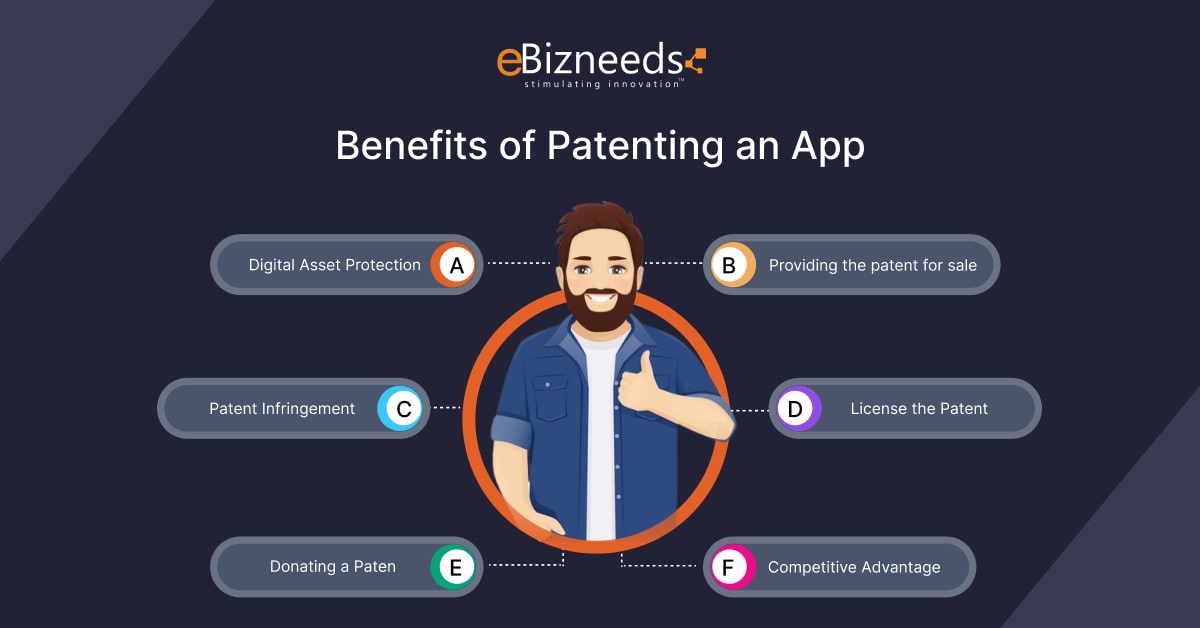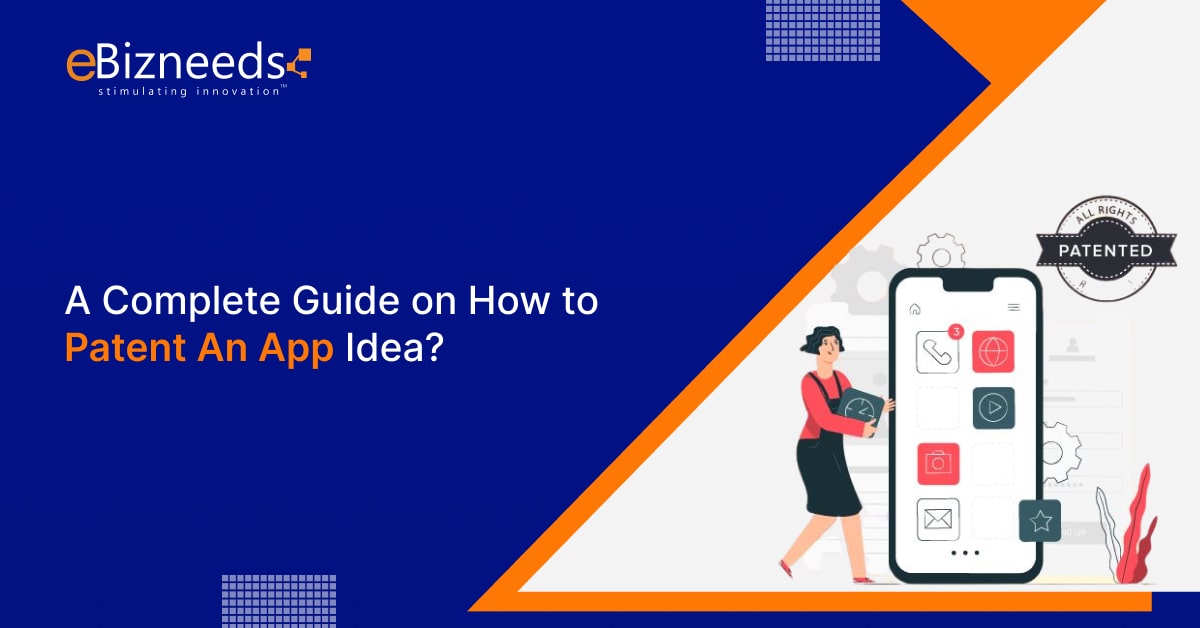Last updated on June 27th, 2024 at 09:49 am
It takes a tremendous amount of creativity to develop a fresh and original concept. When it relates to mobile applications, this situation constantly occurs. Your app has to distinguish itself and be powerful enough to persuade more clients in the face of the market’s increased competition.
It is natural to be concerned, and rightly so, that someone else will attempt to copy that app by developing a similar one.
But you can prevent the app or project from being replicated. It could be attained by securing a patent for your application idea. Before we get into how to patent an app idea, let us define a patent.
What is a Patent?
Have you ever heard the phrase “Patent if you’re anxious to start your own business”? A patent is often a kind of intellectual property that protects your app concept from unethical or illegal use.
Furthermore, by designating you as the exclusive owner of your app concept, it prevents people and businesses from altering or selling it.
Furthermore, a patented app would ensure that no one fraudulently claimed or ruined the credit for your app idea.
Why is Patenting Important?
It is basic evidence that a smartphone app must be covered inclusively under authorized protection. Furthermore, the official patent law allows claimants to seek compensation for any violation of the existing patent law.
Let us check out some of the reasons why patenting an app idea is vital.
- No third party would be able to profit from your patent or app idea.
- Your patented app is largely evidence of the creativity and distinctiveness of your app idea.
- If you address any duplicate of your unique app, you have the legal right to accuse an individual or mobile app development company who announced it first.
What Are the Different Types of Patent Applications?
Various types of apps must be included in a patent for mobile applications or ideas for developing mobile apps. In the coming times, it can prove to be very effective. The details regarding the types of patent applications have been elaborated below.
Provisional Application
A provisional app procedure is one of the easiest and most common approaches to filing a pattern app for protecting your mobile app idea or the app itself. The provisional app is important in various global economies and is widely used to maintain innovation and creativity.
Any type of legal compliance is not required for such an app, and it is a highly informal method of ensuring the security of your mobile app or mobile app idea.
This application is highly time-saving because the applicant does not have to get involved with any legal implications or formalities. Without a public statement of a patent app and a distributor statement, the provisional app may be submitted.
It provides 12 months for developing and refining the prototype completely. Along with this, it permits you to utilize the term “patent pending” on the product. Contrasted to other apps, the provisional app requires some expenses.
Non-Provisional Application
It is another type of app that ensures your safety through mobile app ideas or mobile apps. But it is a challenging procedure. Let us assume that you have the will to file a non-provisional application to patent your app idea.
In that case, you should be well-versed in the evidence demonstrating that this technique would necessitate a greater number of legal formalities and obstacles. It should also be accumulated before getting access to the patent.
A large number of legal complications must be addressed with extreme caution. Since a single error might make the process of obtaining a patent claim more uncomfortable and unbalanced.
It can be highly time-consuming, and unlike the provisional app, it is costly. This sort of app should be accompanied by specifications and claims. Moreover, the non-provisional patent application must consider complete data.
It should be about the innovation or app idea, as well as at least one right that will legally demonstrate the limits of the app idea or app deployment.
When you are confused regarding selecting the right type of app, you should ask yourself these questions initially.
- How promptly do you want your patent application to be settled?
- For how long can you plan to delay the patent application scrutiny cost?
If you are unsure how to answer these questions, contact eBizneeds‘ mobile app development services, where dedicated developers can help you to decide what type of patent app protection is best for your business.
How Do I Patent An app Idea?
Let’s explore some steps to patent your mobile app idea.


Step 1: Find and Register With a Patent Lawyer
The best way is to approach a consulting agency and hire a patent lawyer to initiate patenting an app idea. They should be experienced in software patenting. It is required, so you get a correct and high-quality product that will increase the chances of your app being chosen.
Step 2: Document the App Development Process
Before issuing your patent, the court will ask for proof of your invention. The idea will not solely contribute, and you must check it by bringing it to reality.
You can complete this by designing a prototype of your application. It will let your lawyer assess diverse elements of your app that can be patented.
Step 3: Do Further Research On Your Idea
The patent attorney would also conduct international research on various sources to address ideas and app flows similar to yours. It will give you a wider scope for revamping your idea and ensuring it is unique.
Step 4: File a Provisional Patent App Idea
To ensure that it is not stolen, you can file a provisional application without formal patent validation. It’s because, in the course of getting permitted for a patent, you must disclose your idea and prototype of the application.
There are some benefits to filing a provisional application.
- More affordable than non-provisional applications
- You get 12 months to generate the MVP.
- You can use the tag “Patent Pending” on the application.
Step 5: Submit Your Patent App Idea
It is the last step, wherein you will file the patent application with your nation’s registered trademark and patent office. There are certain documents you will require when completing this. They are:
- Data Disclosure Statement (DDS)
- Requirements
- Entity
- Status Document
- Statement
- App Information Sheet
- Designs, Claims
- Fee Schedule
- Cover Plan
Hence, these are the steps that you should consider to patent an app idea effectively. When the patent is approved, the next step is to build the app in a feasible manner.
You can also consult an app developer like eBizneeds with a relevant background in this area.
How Do You Know If Your Mobile App Idea is Eligible For Patenting?
Here, we are going to discuss the prime aspects that determine the patent eligibility of a mobile app idea. They are discussed as follows:
It should be qualified as useful
Being skilled as a useful app does not imply that your app idea cannot fall under the entertainment category or something similar. Your app just requires some theory, at least. This constraint prevents individuals from patenting these apps that are not applicable.
Therefore, you should develop a concrete and detailed description, such as how your app performs, to claim it as an asset.
It Must Be a New Idea
Patents are considered to secure innovation. According to WIPO (The World Intellectual Property Organisation), they are offered an invention that is discussed as a solution to each concern.
Since the idea of a mobile app is not a physical element, the app procedure is classified as an invention. However, the process must fix each concern, just like any innovation.
Your app idea should be unique and new
Even if your concept for a mobile application resolves the user’s problem, that does not always mean it is eligible for a patent. Your application concept should be fresh and unique. Regardless of how innovative your app idea is, once your concept is distinct and ready to be patented, it can also open the door to international markets. For instance, if you aim to protect your intellectual property in Canada, learning about patentability basics in Canada is crucial. Understanding this process ensures that your exceptional app idea remains safeguarded within a new legal context.
Considering YouTube, articles, videos, pending patent applications, books, and other sources, it should not come out before it’s public.
It must be distinctive and not already available; otherwise, you cannot patent it. You can hire dedicated developers to make your app idea unique and new.
When Do You Need To File For A Patent?
In current times, patenting an app is not limited to the individuals who invented it initially, but is limited to the individuals who file the patent against it.
It is a significant reason why business owners and start-ups like to file a provisional patent before demonstrating key features publicly.
You will address different patent lawyers who suggest patenting an app idea before illustrating it to any capable investor. If you have used a non-disclosure agreement, you can get ready to file quickly.
What Criteria Must Be Fulfilled Before Patenting Your App Idea?
The three key criteria on which your application would be evaluated are often the same across all countries. The same rules that govern how to patent an app apply here as well.
- You must cross this first need off the list. An app concept cannot be patented in and of itself. As a result, while applying for a patent for an app, you must consider all the relevant specifications and project planning, including the app’s coding, functionality, as well as flow, in the light of whether or not the app is realistic and practical.
The first stage seems to be to determine if the patent requires a specific abstract notion, like an algorithmic calculation approach, or another accepted norm.
If it had, the process might have moved into the next stage. If not, it was noted that the claim could be patentable in light of the other two criteria.
The second phase of the case required the court to decide whether the patent claim added anything to the abstract notion beyond what was previously known. Additionally, it might have a creative component. The suggestion would be regarded as invalid if the response is negative.
- Understanding if the invention (or application, as you may like), is new or not, is the second need for how to design a patent for an app. It means the app should offer something distinctly unique and unusual. Therefore, you must check to see whether your concept has already been patented. You might face a violation if your request for a patent is denied. Therefore, do your research. For address-related issues, use Google Patents or the USPTO website.
- The third and maybe most difficult rule is that the mobile application should not be immediately visible. When your task consists only of the merger or incorporation of slightly modified versions of the present technology without considering any special functionality or characteristics. It suggests that your project would not be approved.
Benefits of Patent An App Idea


Before now, you have to understand all the essentials of mobile applications. Let us start to discuss the two different benefits of patenting an app.
Digital Asset Protection
You can secure the digital assets that have been developed or the ones that are still in process by patenting your mobile app.
Furthermore, another advantage to patent an app idea is that you can obtain grievances, damages, and compensation for infringement or imitation of the app idea.
Providing the patent for sale
Patents are intangible resources but they can be bought and sold like tangible resources. When you are dealing with a small business and need financial support, the best way for transforming your invention into cash is by moving your rights for the patent to someone else.
A key strategy to sell a patent in a limited amount of time is to address a patent broker, who acts as a mediator between you and the interested party. It can be any institution, business, or organization.
But, also ensure that the feasible broker is selected whose network is closely associated with the technology area.
The other strategy would be a public auction in which different interested buyers are addressed and bidding is performed for finalizing the rate of your patent.
Patent Infringement
You can also seek products that are violating your patent. Addressing infringement can act to attain a higher financial return. There are different choices available when someone infringes on your patent.
One would be to license your patent to the infringer and the other is to file an infringement suit against the infringer.
License the Patent
If you wish to continue to own the patent rights, the best strategy is to license your patent to firms that give attention to your innovation. According to experts, they can compensate you with royalties ranging from 3 to 20% of the product’s sale, as well as royalties that can be expected until the patent expires.
If the technical value would be higher, the monetary value of your patent would be also higher.
Donating a Patent
When you want to be generous and kind, donating your patent to any company that could be an institution and small level company would be the best choice. It could also decline your tax liabilities.
Competitive Advantage
Innovation and creativity are two key drivers for success in the app sector. In such circumstances, filing a patent for your app idea or app can prevent your rivals from penetrating the market before you act.
If you implement a provisional patent for an app, you can have your app labeled as “patent pending” from a technical standpoint. The specialized patent you get in such a situation has unique filing data.
In such a manner, no other business can redevelop your app idea without getting your permission.
How to Determine Whether Your App Concept Has Previously Been Patented or Not
You should check to see whether a potentially distinctive mobile app idea has already been patented by someone else. As a result, any connected app concept that is either promoted or delayed must be thoroughly studied.
Your region or state should have a database that works and keeps this idea safe and easy to find.
Additionally, you may evaluate using the WIPO’s IPC Catchword Ranking, which takes data related to several international patents into account. In this case, you can comprehend how to patent a mobile app idea.
What Documents and Information Do You Need to File your Idea for Patenting An App?
You may have asked yourself, “How do I patent an app idea? “After you have planned the patent application, you must file it with the USPTO. Due to more paperwork, the procedure may become tedious over time.
You can take assistance from a patent attorney if necessary. We have discussed the required documents you need to smooth the procedure.
- Specification
- Declaration
- Statement of Information Disclosure
- Entity Status Form
- Claims
- Patent Cooperation Agreement (for international filings),
- Front Sheet
- Specifications for developing the app (optional)
- Fee Sheet
- Drawings
How Much Does It Cost To Patent An App Idea?
According to the type of patent, different charges may apply to patenting mobile apps.
Provisional patents may cost between $2,000 and $5,000.
After making a provisional patent, you can improve your mobile app and think about how to sell it.
Keep in mind that a provisional patent is only valid for one year after financing.
Provisional patents cost between $100,000 and $15,000 to get.
What Alternatives Exist to Patent Your App Idea?
We will talk about several mobile application patent alternatives below:
Copyright
Copyright is another sort of IPR, including patents. To address the rights granted to the creator or innovator for any project, including academic, lyrical, computer program, intellectual, and aesthetic works, it is helpful to distinguish between these two terms.
Furthermore, it grants them the right to duplicate the work, publicize it, and create derivatives of it, regardless of whether it is active or not.
Additionally, it hinders the transmission of ideas, not just ideas themselves. Since the app logo does not include facts, ideas, systems, or ways to run the app, we could copyright the logo instead of the app itself.
NDAs (non-disclosure agreements)
An NDA is a legal contract involving you and an on-demand app development company that has been authorized by the businesses you work with. It legally obligates them to maintain the privacy of the concepts and methods used in your program.
As a result, it protects the idea from the outside application.
Trademark patents eliminate competitors’ prospects of making or selling your invention.
On the other hand, a trademark protects any logos, signs, slogans, or other tools that help people recognize the original company’s products and services and forbids other businesses from using them.
To prevent rivals from ripping off your app’s logo as well as ambiguous clients, you would have the opportunity to register it as a trademark.
Conclusion
This may appear to be a time-consuming task, but in the long run, patenting may be the best option. Because there is an assurance to safeguard your app ideas,
You do not need to bother with replicating the app because this creative strategy will be in your hands.
If you have an idea for a mobile application or are already developing one, now is the time to patent it.
FAQs
What are the aspects of the app that can be used to patent an app idea?
You may patent a variety of features in your mobile application, including data moving, communication, connectivity, data protection, database construction, sending feedback, as well as server functionality.
How can you tell whether or not your app idea has previously been patented?
By logging into the Google Patents website or the USPTO website and searching for workable keywords for any patent filed, you may quickly determine if someone else has previously patented your application idea.
What are the alternatives to patent your mobile app idea?
There are some alternatives to patenting an app that secures your app idea, like trademarks, copyrights, and non-disclosure agreements (NDAs).



Naveen Khanna is the CEO of eBizneeds, a company renowned for its bespoke web and mobile app development. By delivering high-end modern solutions all over the globe, Naveen takes pleasure in sharing his rich experiences and views on emerging technological trends. He has worked in many domains, from education, entertainment, banking, manufacturing, healthcare, and real estate, sharing rich experience in delivering innovative solutions.





